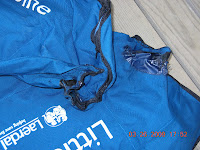At least the house didn't burn down

While I was planning on blogging exclusively on nutrition this month I thought I'd share our little emergency today. The interesting picture is what Laerdal Little Anne mannequin bags look like after they've melted from extreme heat. Yup, we almost set the house on fire today. Not a proud thing for a CPR & First Aid Instructor to admit. While picking up the basement I put the bags on top of my pellet stove so the kids could ride their tricycles in the basement. The stove was off, was cool to the touch and the burn chamber was empty because I had cleaned just a little while beforehand. When the kids started fighting over toys I took my youngest upstairs for snack leaving my 3 year old playing downstairs. I never would have imagined that he would open the little door on the side and turn up the thermostat on the pellet stove. He turned it up high enough that it loaded pellets and ignited. I smelled the burning plastic and found him hiding in the basement. The basement